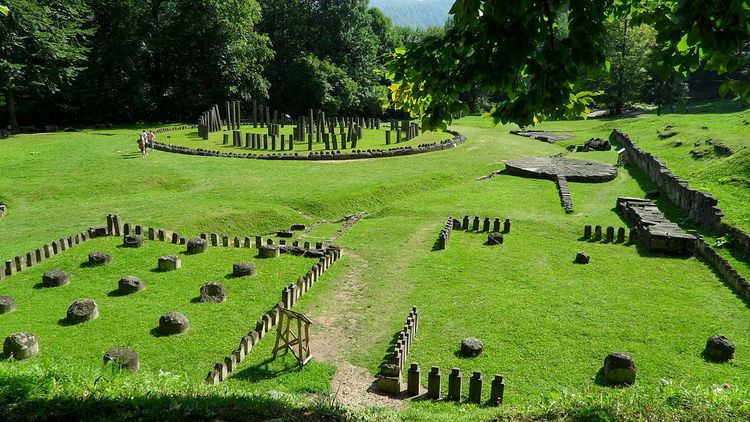Altitude 1,030 m (3,379 ft) Phone +40 722 409 633 | Abandoned 2nd century AD | |
 | ||
Alternate name Dacian capital, Sarmisegetusa, Sarmizegethusa, Sarmisegethusa, Sarmisegethuza, Sarmageze, Sarmategte, Sermizegetusa, Zarmizegethusa, Zarmizegethousa, Zarmizegetusa, Zermizegethouse Archaeologists A. RusuA. SionEugen IaroslavschiH. G. SeiwerthIoan AndrițoiuIoan GlodariuŞtefan FerencziGelu FloreaGabriela GheorghiuDarius SimaAdriana Pescaru RusuLiliana Dana Suciu Condition Partially reconstructed Similar Dacian Fortresses of the Oră, Costești‑Blidaru Dacian fortress, Costești‑Cetățuie Dacian fortress, Piatra Roșie Dacian fo, Prislop Monastery | ||
Sarmizegetusa regia documentar istoric
Sarmizegetusa Regia, also Sarmisegetusa, Sarmisegethusa, Sarmisegethuza, Ζαρμιζεγεθούσα (Zarmizegethoúsa) or Ζερμιζεγεθούση (Zermizegethoúsē), was the capital and the most important military, religious and political centre of the Dacians prior to the wars with the Roman Empire. Erected on top of a 1200 m high mountain, the fortress, comprising six citadels, was the core of a strategic defensive system in the Orăştie Mountains (in present-day Romania).
Contents
- Sarmizegetusa regia documentar istoric
- Etymology
- Layout
- Variants of the Name of the City
- Pre Roman era
- The defensive system
- Roman era
- References
Sarmizegetusa Regia should not be confused with Ulpia Traiana Sarmizegetusa, the Roman capital of Dacia built by Roman Emperor Trajan some 40 km away, which was not the Dacian capital. Sarmizegetusa Ulpia was discovered earlier, was known already in the early 1900s, and was initially mistaken for the Dacian capital, a confusion which led to incorrect conclusions being made regarding the military history and organization of the Dacians.
Etymology
Several hypotheses have been advanced to explain the origin of the name Sarmizegetusa. The most important of these ascribe the following possible meanings to the city's name:
Layout
Sarmizegetusa Regia contained a citadel and residential areas with dwellings and workshops as well as a sacred zone.
The archaeological inventory found at the site demonstrates that Dacian society had a relatively high standard of living.
Variants of the Name of the City
Historical records show considerable variation in the spelling of the name of the Dacian capital:
Pre-Roman era
Towards the end of his reign, Burebista transferred the Geto-Dacian capital from Argedava to Sarmizegetusa. Serving as the Dacian capital for at least one and a half centuries, Sarmizegethusa reached its zenith under King Decebal. Archeological findings suggest that the Dacian god Zalmoxis and his chief priest had an important role in Dacian society at this time. They have also shed new light on the political, economic and scientific development of the Dacians and their successful assimilation of technical and scientific knowledge from the Greek and Romans.
The site has yielded two especially notable finds:
The smithies north of the sanctuary also provide evidence of the Dacians' skill in metalworking: findings include tools such as meter-long tongs, hammers and anvils which were used to make some 400 metallic artefacts — scythes, sickles, hoes, rakes, picks, pruning hooks, knives, plowshares, and carpenters' tools — as well as weapons such as daggers, curved Dacian scimitars, spearpoints, and shield-bosses.
Nevertheless, the flowering of Dacian civilization apparently underway during the reign of Decebalus came to an abrupt end when Trajan's legions destroyed the city and deported its population.
The defensive system
The Dacians capital’s defensive system includes six Dacian fortresses — Sarmizegetusa, Costești-Blidaru, Piatra Roșie, Costeşti-Cetățuie, Căpâlna and Băniţa. All 6 have been named UNESCO World heritage sites.
Roman era
Sarmisegetusa's walls were partly dismantled at the end of First Dacian war in AD 102, when Dacia was invaded by the Emperor Trajan of the Roman Empire. The Dacians rebuilt them. The Romans systematically destroyed them again in 106 and deported the inhabitants.
The Roman conquerors established a military garrison at Sarmisegetusa Regia. Later, the capital of Roman Dacia was established 40 km from the ruined Dacian capital, and was named after it - Colonia Ulpia Traiana Augusta Dacica Sarmizegetusa.
